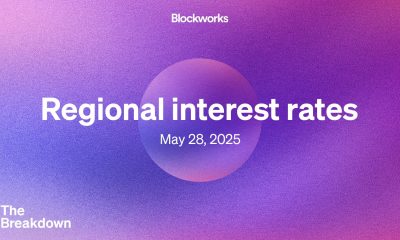

others
Mexican Peso erases earlier losses against the USD, turns bullish on risk-on mood – Crypto News
- Mexican Peso drops amid the lack of economic data, but remains inside the 17.00/17.60 range.
- Banxico to remain cautious despite easing policy for the next year commented its Governor Rodriguez Ceja.
- Federal Reserve officials pushed back against aggressive bets suggesting the central bank would cut rates twice its projections.
The Mexican Peso (MXN) stages a comeback against the US Dollar (USD), and is virtually unchanged, registering minuscule gains of 0.04%, despite dovish comments from the Bank of Mexico (Banxico) Governor Victoria Rodriguez Ceja crossing the newswires. In the meantime, Federal Reserve (Fed) officials pushed against aggressive rate cuts bets by the market, which expects more than 140 basis points of easing. At the time of writing, the USD/MXN is trading at 17.17, down after hitting a daily high of 17.29.
Mexico’s economic docket remains scarce, though Banxico’s Governor Rodriguez Ceja grabbed the headlines. She commented that inflation has fallen, but they remain cautious about when beginning to ease monetary policy. She added that they’re anticipating cutting rates “gradually.”
Daily digest market movers: Mexican Peso on the defensive amidst Banxico’s dovish comments
- Banxico’s Governor Victoria Rodriguez Ceja noted that if data supports the disinflationary process, they could ease monetary policy in the first quarter of 2024.
- Bank of Mexico’s Governor added that despite reviewing their inflation projections for 2024, the central bank kept its forecast of inflation returning to its 3% target in 2025.
- Lastly, Victoria Rodriguez Ceja added the Governing Council considers several factors when determining its policy, including the exchange rate, though they’re not focused on a specific level.
- Banxico’s decision to keep rates unchanged last week was unanimously supported by its five members.
- The central bank acknowledged that inflation risks are tilted to the upside after November’s report witnessed headline inflation rising due to the “rise in non-core components” while core inflation eased.
- Banxico revised its inflation projections for some quarters of 2024 and 2025.
- US business activity picked up in December, according to S&P Global. The composite index, which combines manufacturing and services sectors, increased to 51, exceeding November’s 50.7 and hitting a five-month high.
- Federal Reserve official Raphael Bostic projects two rate cuts next year and a soft landing. Nevertheless, he added the US central bank must be resolute, and that rate cuts are not imminent.
- Aside from this, the New York Fed President John Williams pushed back against the idea of rate cuts, emphatically saying it’s “premature” to think about easing policy in March.
- Williams added that the question around the Fed board is whether the policy is sufficiently restrictive enough to ensure inflation returns to 2%.
- According to the Summary of Economic Projections (SEP), Fed officials expect to lower the federal funds rates (FFR) to 4.60% in 2024, though they remain data-dependent.
- The fall in US Treasury bond yields, which are closely correlated to the Greenback (USD), has stalled, easing the pressure on the USD. The US Dollar Index (DXY) is virtually unchanged, falls 0.02%, up at 102.57.
- Money market futures estimate the Fed will slash rates by 140 basis points toward the end of next year, twice the Fed’s forecasts of three 25 bps cuts.
Technical analysis: Mexican Peso to remain rangebound at around 17.00-17.60
The USD/MXN is rangebound as the 100, 200, and 50-day Simple Moving Averages (SMAs) begin to converge toward the 17.41/58 area, almost shifting flat. As long as the exchange rate remains below them, it would remain slightly tilted to the downside, with the first support level seen at last week’s low of 17.14, ahead of dropping toward the 17.00/05 area.
On the other hand, if buyers reclaim the 100-day SMA at 17.41, the USD/MXN could rally toward the 200-day SMA at 17.51 in route to the 50-day SMA at 17.58. Once those levels are surpassed, further upside lies at the psychological 18.00 figure.
Central banks FAQs
Central Banks have a key mandate which is making sure that there is price stability in a country or region. Economies are constantly facing inflation or deflation when prices for certain goods and services are fluctuating. Constant rising prices for the same goods means inflation, constant lowered prices for the same goods means deflation. It is the task of the central bank to keep the demand in line by tweaking its policy rate. For the biggest central banks like the US Federal Reserve (Fed), the European Central Bank (ECB) or the Bank of England (BoE), the mandate is to keep inflation close to 2%.
A central bank has one important tool at its disposal to get inflation higher or lower, and that is by tweaking its benchmark policy rate, commonly known as interest rate. On pre-communicated moments, the central bank will issue a statement with its policy rate and provide additional reasoning on why it is either remaining or changing (cutting or hiking) it. Local banks will adjust their savings and lending rates accordingly, which in turn will make it either harder or easier for people to earn on their savings or for companies to take out loans and make investments in their businesses. When the central bank hikes interest rates substantially, this is called monetary tightening. When it is cutting its benchmark rate, it is called monetary easing.
A central bank is often politically independent. Members of the central bank policy board are passing through a series of panels and hearings before being appointed to a policy board seat. Each member in that board often has a certain conviction on how the central bank should control inflation and the subsequent monetary policy. Members that want a very loose monetary policy, with low rates and cheap lending, to boost the economy substantially while being content to see inflation slightly above 2%, are called ‘doves’. Members that rather want to see higher rates to reward savings and want to keep a lit on inflation at all time are called ‘hawks’ and will not rest until inflation is at or just below 2%.
Normally, there is a chairman or president who leads each meeting, needs to create a consensus between the hawks or doves and has his or her final say when it would come down to a vote split to avoid a 50-50 tie on whether the current policy should be adjusted. The chairman will deliver speeches which often can be followed live, where the current monetary stance and outlook is being communicated. A central bank will try to push forward its monetary policy without triggering violent swings in rates, equities, or its currency. All members of the central bank will channel their stance toward the markets in advance of a policy meeting event. A few days before a policy meeting takes place until the new policy has been communicated, members are forbidden to talk publicly. This is called the blackout period.
-

 Cryptocurrency1 week ago
Cryptocurrency1 week agoThe monetary power of the periphery: How Dallas defends the dollar – Crypto News
-

 Cryptocurrency1 week ago
Cryptocurrency1 week agoNifty 50 Ends Higher After Two-Day Drop, But Bulls Struggle to Break 25,000 – Crypto News
-

 Cryptocurrency1 week ago
Cryptocurrency1 week agoXRP drops 1.05% as resistance levels cap recovery – Crypto News
-

 others1 week ago
others1 week agoGold surges above $3,300 as US jobs data disappoints, Trump tariffs blocked – Crypto News
-

 others1 week ago
others1 week agoTrader Michaël van de Poppe Says Ethereum-Based Altcoin Primed To Do Well in Coming Months, Updates Outlook on Bitcoin and Sui – Crypto News
-

 Blockchain1 week ago
Blockchain1 week agoTesting Strength At Key Support – Crypto News
-

 Technology1 week ago
Technology1 week agoCool savings for a hot season: Top 10 deals for you on ACs, refrigerators, microwaves, and more with up to 60% off – Crypto News
-

 Cryptocurrency1 week ago
Cryptocurrency1 week agoOne day left to invest in Bitcoin Pepe before it hits centralised exchanges – Crypto News
-

 Cryptocurrency1 week ago
Cryptocurrency1 week agoCoinbase helps bust $20M spoofing case – Crypto News
-

 Cryptocurrency1 week ago
Cryptocurrency1 week agoSOL Strategies Files $1B Shelf Prospectus to Boost Solana Investment ‘Flexibility’ – Crypto News
-
Technology1 week ago
Why Is Pepe Coin Trending Today? – Crypto News
-

 Technology1 week ago
Technology1 week agoWhatsApp Status gets new Instagram-like features: Here’s what’s new – Crypto News
-
Cryptocurrency7 days ago
Can Shiba Inu Price Recover as Age Consumed & Falling MVRV Signal Bottom? – Crypto News
-

 Blockchain6 days ago
Blockchain6 days agoCzech Justice Minister Resigns Over $45M Bitcoin Donation Scandal – Crypto News
-

 Cryptocurrency1 week ago
Cryptocurrency1 week agoLitecoin price forecast: tracking LTC’s bullish technical setup – Crypto News
-

 Cryptocurrency1 week ago
Cryptocurrency1 week agoLitecoin price forecast: tracking LTC’s bullish technical setup – Crypto News
-

 Cryptocurrency1 week ago
Cryptocurrency1 week agoCold Summer? Bitcoin Price Breaches $105K Support As Tariffs Return to Play – Crypto News
-
Business1 week ago
Sharplink Gaming Files $1 Billion Shelf Offering To Purchase Ethereum – Crypto News
-
others1 week ago
Sharplink Gaming Files $1 Billion Shelf Offering To Purchase Ethereum – Crypto News
-

 Cryptocurrency7 days ago
Cryptocurrency7 days agoBitcoin in ‘make or break’ zone – Trump Media hints at what’s next – Crypto News
-

 Blockchain6 days ago
Blockchain6 days agoBitcoin Still Bullish, But $200,000 Off The Table And $137,000 In Sight – Crypto News
-
Technology6 days ago
Just-In: IMF Raises Red Flag Over Pakistan’s Bitcoin Mining Plans, Is $1.5B IMF Loan at Risk? – Crypto News
-

 Blockchain1 week ago
Blockchain1 week agoBitcoin $106,800 Support Retest To Determine BTC’s Next Move – Crypto News
-

 Blockchain1 week ago
Blockchain1 week agoRBI Expands Digital Rupee Pilots, UPI Leads Global Real-Time Payments – Crypto News
-

 Blockchain1 week ago
Blockchain1 week agoTelegram raises $1.7 billion via bond offering – Crypto News
-

 Cryptocurrency1 week ago
Cryptocurrency1 week agoXRP futures surge past $223M as price holds $2.27 support – Crypto News
-

 others1 week ago
others1 week agoBankrupt Crypto Exchange FTX Officially Kicks Off Second Round of Creditor Repayments With $5,400,000,000 Distribution – Crypto News
-

 others7 days ago
others7 days agoJPMorgan Chase CEO Warns US Bond Crisis Coming After Massive Money Printing, Says Regulators Will Panic – Crypto News
-

 Blockchain1 week ago
Blockchain1 week agoUS court freezes $57M USDC allegedly linked to LIBRA scandal – Crypto News
-

 others1 week ago
others1 week agoGold rebounds as US Dollar retreats while court strikes down Trump’s tariffs – Crypto News
-

 Blockchain1 week ago
Blockchain1 week agoEthereum Price Faces Mild Correction — Support Levels in Focus – Crypto News
-
Business1 week ago
XRP Crash: Why Price Is Falling Today? – Crypto News
-
Business1 week ago
Floki Inu Announces Valhalla Mainnet Launch Date; FLOKI Price to Rally? – Crypto News
-

 Metaverse1 week ago
Metaverse1 week agoIndiaAI Mission gets 16,000 new GPUs, three more foundational models – Crypto News
-

 others1 week ago
others1 week ago$413,200,000,000 in Unrealized Losses Hit US Banks As FDIC Warns Rising Rates Adding Pressure – Crypto News
-

 Cryptocurrency1 week ago
Cryptocurrency1 week agoFriday Charts: Click here for good news – Crypto News
-

 Blockchain7 days ago
Blockchain7 days agoMajor crypto hacks fell 40% in May, says PeckShield – Crypto News
-
Business6 days ago
Michael Saylor Signals Another Massive Strategy Bitcoin Purchase – Crypto News
-
Business6 days ago
XRP Las Vegas: Brad Garlinghouse Says Bitcoin Is Not The Enemy – Crypto News
-

 Blockchain6 days ago
Blockchain6 days agoStrategy signals another Bitcoin buy on June 2 – Crypto News
-

 others5 days ago
others5 days ago‘Nothing Stops This Train’ – Macro Guru Lyn Alden Warns Fed Has No Way To Slow Down Debt Growth in US Financial System – Crypto News
-
Cryptocurrency5 days ago
Ethereum’s Pectra Upgrade leaves massive loophole for scammers – Crypto News
-
Technology1 week ago
Solana’s Downfall Could Fuel Ethereum Price Rally to $3,500 – Crypto News
-
Business1 week ago
Trump Tariffs Struck Down By US Courts, ‘Buy Everything’ Says Arthur Hayes – Crypto News
-

 Blockchain1 week ago
Blockchain1 week agoCrypto lobby group says SEC should back off regulating most DAOs – Crypto News
-

 others1 week ago
others1 week agoTrader Who Called 2021 Bitcoin and Crypto Collapse Says Key Indicator Now Flashing Green – Crypto News
-

 Blockchain1 week ago
Blockchain1 week agoBitcoin $106,800 Support Retest To Determine BTC’s Next Move – Crypto News
-
Business1 week ago
Is Meta Adopting Bitcoin? What’s behind Strive CEO and Mark Zuckerberg Meeting – Crypto News
-

 Cryptocurrency1 week ago
Cryptocurrency1 week agoQuant (QNT) rally pauses at $123, Sell-off or surge ahead? – Crypto News
-
others1 week ago
Crypto Couple Kidnapped In Argentina, Freed After $43K Ransom – Crypto News


















